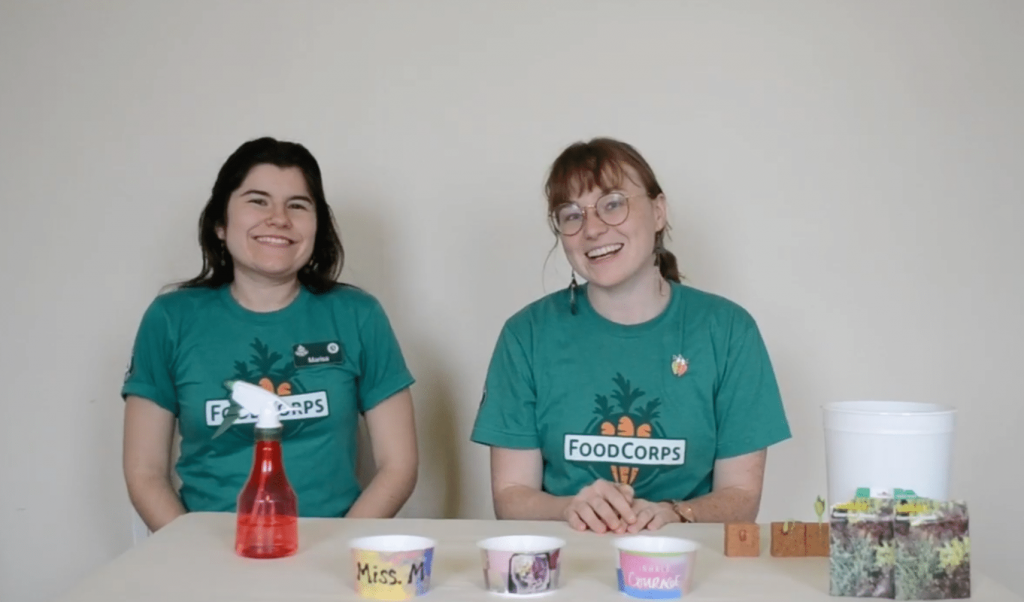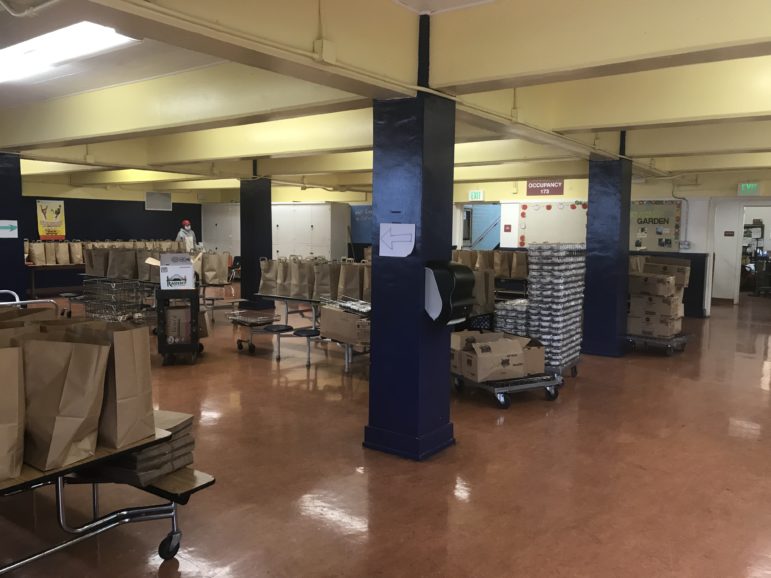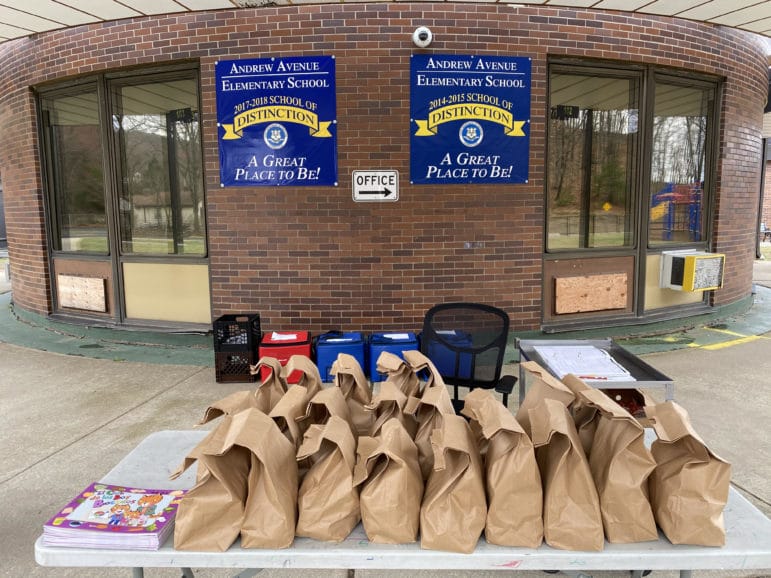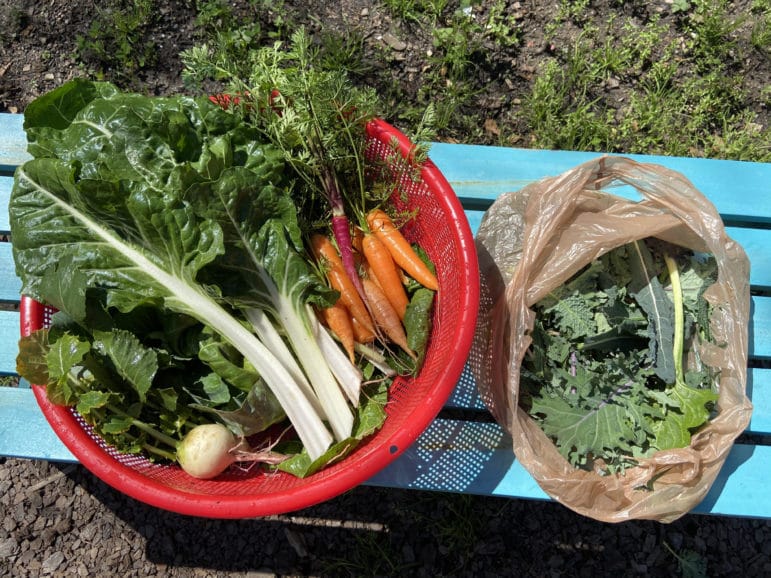Service Through COVID-19: Supporting Our Schools and Communities
Here’s how FoodCorps service members are continuing to connect kids to healthy food, even as schools close in response to COVID-19.
Here’s how FoodCorps service members are continuing to connect kids to healthy food, even as schools close in response to COVID-19.

Every year, approximately 75,000 people sign up to serve with AmeriCorps, a national service program that supports people and communities across the nation. Every day AmeriCorps members serve in a wide variety of ways, from building affordable housing, to supporting seniors, to mentoring teens, to teaching about the importance of healthy food. AmeriCorps members and programs provide a fundamental service to our country—one that is playing a critical role in responding to the national crisis caused by COVID-19.
At FoodCorps, our AmeriCorps service members connect kids with healthy food in more than 350 schools across the country. With all of our schools closed, many indefinitely, service members have adapted quickly to the shift in service, in part by following the very same advice they give their students: let’s try things!
As schools close and education shifts online, service members are listening, collaborating, and taking action to serve their communities through COVID-19 in new ways. The methods of service may be different from “business as usual,” but the purpose that drives them to serve remains the same.
Elayna Shapiro, FoodCorps Service Member at Montana’s Polson School District #23, said it best: “Service can look very different across our communities. For some service members, we are able to help with meal preparation and food distribution. For others, we are developing remote learning resources. For all of us, we are simply using the tools around us to best serve our communities. While the circumstances have changed, our mission has not, and we are all doing what we can to continue to serve during this unusual time.”
FoodCorps is incredibly proud of our AmeriCorps service members’ leadership, and we want to highlight a few stories of how they are continuing to connect kids to healthy food now that schools are closed.
More than 30 million kids rely on school cafeterias for nourishment, and with schools closed, kids stand to go hungry without immediate and sustainable interventions. School nutrition professionals are leading our nation’s largest emergency feeding effort in generations and standing with doctors, EMTs, firefighters, police officers, and other first responders on the front lines of the response. To support these school nutrition heroes in connecting kids with their next meal, FoodCorps service members are lending a hand with emergency meal distribution.

From Emma Greenberg-Bell, FoodCorps Service Member, Oakland Unified School District, California:
“Our school’s nutrition services staff quickly created a ‘grab n’ go’ meal pick-up service at 12 locations in the school district. On the first day, we served 24,000 meals, and ever since, the number of meals served has grown. It’s been inspiring to see our community come together in this crisis. Just yesterday, we had our cafeteria manager, custodians, teachers, cafeteria staff from other schools, and myself working together to prepare and distribute bags of food to our community. Along with the school meals, we distribute fruit and non-perishables from the county food bank, donations of menstrual products, and bread donations from local bakeries. I’m also helping by delivering food to families who are not able to leave their homes. While this is an extremely stressful, sad, and unpredictable time, it gives me hope to see so many people from across our school district coming together to feed our students, their families, and the entire community.”

From Claire Sickinger, FoodCorps Service Member, Naugatuck Public Schools, Connecticut:
“Naugatuck Public Schools has continued its food services even though schools are closed. We prepare and serve breakfast and lunch for all children of families with at least one child enrolled within the school district. Now, instead of my usual service routine, I go to school and help fill brown bags with all breakfast and lunch components, pack them into coolers, drive them to one of the distribution sites, and give them out to those who want them. I don’t always get to see the kids but it is heartwarming when I hear their family members tell me that they miss seeing me at school every day. I know there are students that would not get enough food to eat if we weren’t distributing meals. In this new capacity, my service means I can connect kids to healthy food in the most literal sense possible… even if I’m doing so from a folding table outside of the school instead of in the classroom, cafeteria, or school garden.”

From Meggie Stewart, FoodCorps Service Member, International Rescue Committee, Georgia:
“At my service site, the International Rescue Committee in Atlanta, we are at a Level 5, which means I’m not allowed to have any contact with the students, so I can’t deliver or serve food myself, but I’m grateful that the organization has policies and staff in place to help address food insecurity. I was able to harvest some vegetables from the garden to supplement the dry foods that they’re delivering to families. I am also calling students and families to check in on them and share information about the emergency meal program and nearby food pantries. I’ve enjoyed speaking with the students and their parents by phone. I think the calls help bring a sense of normalcy as typically I get to talk to the kids at lunch or during our garden club.”
With over 55 million students experiencing school closures, families need support in continuing education for kids at home. To help engage kids, FoodCorps has released 35+ lesson plans for the first time to parents, guardians, and caregivers—the very same lessons that FoodCorps service members lead in schools during a typical service year. Now, instead of teaching lessons in the classroom or school garden, FoodCorps service members are bringing their lessons online. They’re creating video tutorials, webinars, and more to teach kids about culture, language arts, literacy, math, and science with kitchen and garden activities that use common ingredients and materials found at home or close by.
From Ally Staab, FoodCorps Service Member, Norwalk Public Schools, Connecticut:
“My fellow Norwalk service member and I worked together to create a weekly newsletter to send to our students and their families. It contains FoodCorps-related craft ideas, healthy snack recipes, outdoor activities, and educational activities. I’ve been working on setting up a Google Classroom, and we’re planning some fun mini lessons for students, which I think will bring joy during this uncertain time.”

From Leilani Stacy, FoodCorps Service Member, Boston Mayor’s Office of Food Access, Massachusetts:
“My fellow Massachusetts service members and I launched a YouTube page, where we are uploading short video lessons, recipes, and read-alouds to help families engage kids at home. At my service site, the Mayor’s Office of Food Access in Boston, we have also launched an Instagram account to post daily content and continue to engage students.”
As the growing season advances, FoodCorps service members are maintaining the school gardens that are so vital to community-building and nurturing a love of healthy food with students. They are also supporting families who are starting home gardens as sources of resilience, connection, and nourishment. FoodCorps is working to support this return to the earth through take-home lessons, seed packets, and a healthy dose of encouragement, providing the motivation for experiential learning in the garden and guidance to turn backyards and windowsills into sources of healthy food.

From Marisa Kaplita, FoodCorps Service Member, New London Public Schools, Connecticut:
“I am enjoying the challenge of creating activities that students can do at home with whatever materials they have on hand. For example, my fellow service member Courtney Ignace and I made a video that shows how to plant and grow seeds in a recycled yogurt cup that can be decorated and used as a planter pot. We’re also making ‘seed kits’ to send home with the students when they take their breakfast and lunch bags provided by the school district. They will have instructions on how to use the empty containers from the meal packages, and turn them into flower pots. I’m very excited with the new challenge of coming up with more activities similar to this one!”

From Katie Keith, FoodCorps Service Member, Furlow Charter School, Georgia:
“I will still be going to the school grounds to take care of the garden while I can. I intend to dedicate a lot of care to the garden and really get to business in weeding, watering, and planting. Now is the prime time to plant, since the weather is warm but not incredibly hot. I have plans to make sure that the area is shipshape for when school returns.”

From Erin Brenner, FoodCorps Service Member, Detroit Public Schools, Michigan:
“I registered with the Michigan Community Service Coalition to be a part of the COVID-19 food distribution team. I am grateful to have this opportunity to provide direct relief in service to my community. I know the reality: if I were to make video lessons or other online content, it is unlikely that those lessons would be watched by the students. Many households have access to just one smartphone, and some do not have access at all. Instead I’m helping connect the students and families to food, and I’m exploring how to continue to cultivate my school garden so that it is vibrant when schools reopen. I was hoping to clean it up and start seeds, but I was informed that restrictions have been expanded, and I am not allowed to be on school property, including the garden space. Instead, I’m ordering seeds, flats, and a grow light to begin the plants at home, and hopefully, eventually, transplant them to my garden site when restrictions have been lifted.”
FoodCorps applauds Congress for including flexibilities for AmeriCorps in the Coronavirus Aid, Relief, and Economic Security (CARES) Act and recognizing the significance of national service’s people power. But there is more Congress can do to support service members during this time of crisis. The national service community is urging lawmakers to include additional policy changes in the next round of relief package. Sign up for FoodCorps action alerts to learn how you can raise your voice.
FoodCorps is a non-partisan, non-profit organization. FoodCorps staff and FoodCorps AmeriCorps members may not participate in any partisan or seemingly partisan activities during work time charged to a Corporation for National and Community Service funded grant or while earning AmeriCorps service hours. No federal funds were used to prepare or distribute these advocacy actions.

9 Thoughtful Holiday Gifts Made by FoodCorps Alumni

The Policy Brief, Fall 2024: After the Election

Food as Medicine: Teaching Indigenous Foodways